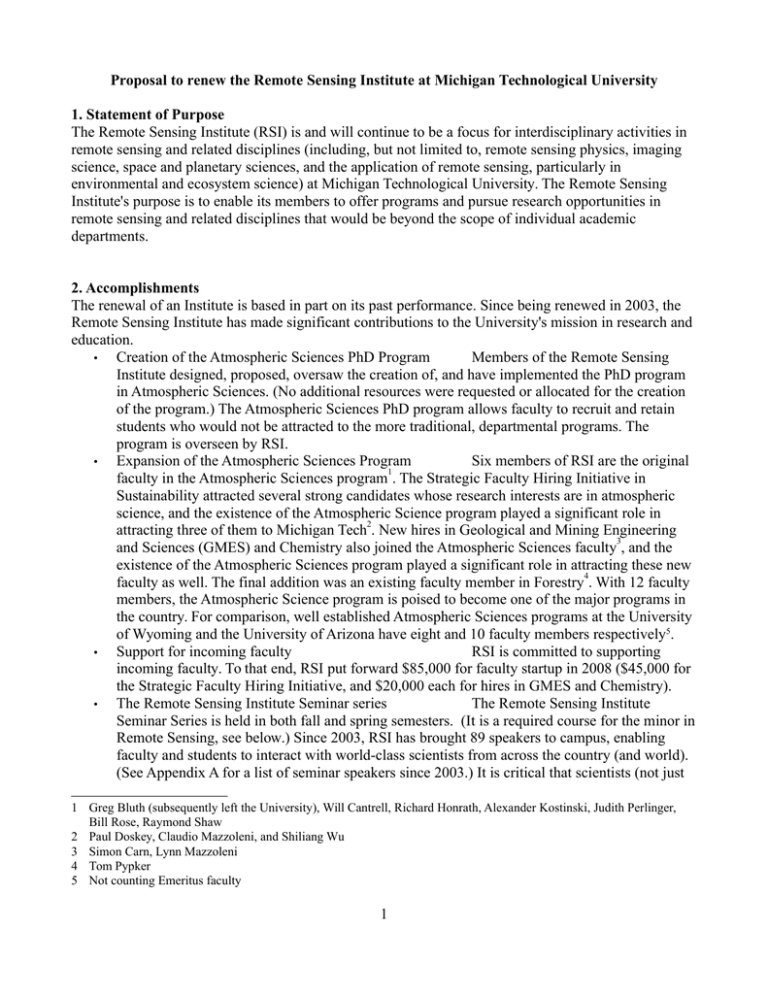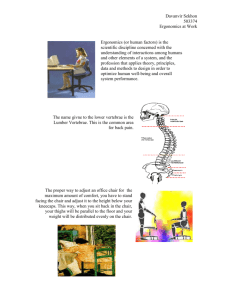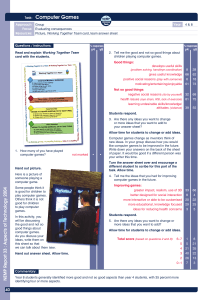Proposal to renew the Remote Sensing Institute at Michigan Technological... 1. Statement of Purpose
advertisement

Proposal to renew the Remote Sensing Institute at Michigan Technological University 1. Statement of Purpose The Remote Sensing Institute (RSI) is and will continue to be a focus for interdisciplinary activities in remote sensing and related disciplines (including, but not limited to, remote sensing physics, imaging science, space and planetary sciences, and the application of remote sensing, particularly in environmental and ecosystem science) at Michigan Technological University. The Remote Sensing Institute's purpose is to enable its members to offer programs and pursue research opportunities in remote sensing and related disciplines that would be beyond the scope of individual academic departments. 2. Accomplishments The renewal of an Institute is based in part on its past performance. Since being renewed in 2003, the Remote Sensing Institute has made significant contributions to the University's mission in research and education. • Creation of the Atmospheric Sciences PhD Program Members of the Remote Sensing Institute designed, proposed, oversaw the creation of, and have implemented the PhD program in Atmospheric Sciences. (No additional resources were requested or allocated for the creation of the program.) The Atmospheric Sciences PhD program allows faculty to recruit and retain students who would not be attracted to the more traditional, departmental programs. The program is overseen by RSI. • Expansion of the Atmospheric Sciences Program Six members of RSI are the original 1 faculty in the Atmospheric Sciences program . The Strategic Faculty Hiring Initiative in Sustainability attracted several strong candidates whose research interests are in atmospheric science, and the existence of the Atmospheric Science program played a significant role in 2 attracting three of them to Michigan Tech . New hires in Geological and Mining Engineering 3 and Sciences (GMES) and Chemistry also joined the Atmospheric Sciences faculty , and the existence of the Atmospheric Sciences program played a significant role in attracting these new 4 faculty as well. The final addition was an existing faculty member in Forestry . With 12 faculty members, the Atmospheric Science program is poised to become one of the major programs in the country. For comparison, well established Atmospheric Sciences programs at the University of Wyoming and the University of Arizona have eight and 10 faculty members respectively5. • Support for incoming faculty RSI is committed to supporting incoming faculty. To that end, RSI put forward $85,000 for faculty startup in 2008 ($45,000 for the Strategic Faculty Hiring Initiative, and $20,000 each for hires in GMES and Chemistry). • The Remote Sensing Institute Seminar series The Remote Sensing Institute Seminar Series is held in both fall and spring semesters. (It is a required course for the minor in Remote Sensing, see below.) Since 2003, RSI has brought 89 speakers to campus, enabling faculty and students to interact with world-class scientists from across the country (and world). (See Appendix A for a list of seminar speakers since 2003.) It is critical that scientists (not just 1 Greg Bluth (subsequently left the University), Will Cantrell, Richard Honrath, Alexander Kostinski, Judith Perlinger, Bill Rose, Raymond Shaw 2 Paul Doskey, Claudio Mazzoleni, and Shiliang Wu 3 Simon Carn, Lynn Mazzoleni 4 Tom Pypker 5 Not counting Emeritus faculty 1 • • graduate students) be exposed to the latest results and ideas. For this reason, the formal presentations that these visitors make while on campus are an invaluable contribution to the University's mission. In many respects, the informal interactions with faculty and students are even more valuable. Moreover, Michigan Tech has a stated goal to become “a national University of choice.” The University's reputation among faculty and scientists at other institutions plays a role in that. We make an effort to ensure that external seminar speakers meet with a range of RSI faculty members, and as a result most or all of them leave with a very favorable impression, contributing to improvements in Michigan Tech's national reputation. We have also used the Seminar series to promote interaction between Michigan Tech's main campus and research staff at the Michigan Tech Research Institute by bringing in MTRI personnel for seminars. The average attendance (estimated) at RSI seminars is 40 ± 10. Great Lakes Laboratory As noted above, the Purpose of the Remote Sensing Institute is to enable its members to offer programs and pursue research opportunities that are beyond the scope of individual departments. The Great Lakes laboratory is an example of such a project. The State Legislature authorized the $25 million project in Fall 2008. The laboratory will enable the study of, for example, Global Climate Change, Invasive Species, and Great Lakes Restoration Projects, all of which are vital to the Great Lakes ecosystem and will foster collaboration with several federal laboratories and regional agencies. Charlie Kerfoot, Sarah Green and Noel Urban (all members of RSI) helped to draft the initial documents proposing the Lab and have subsequently served on key committees. Additional RSI members also developed the proposal for the Air Quality and Meteorology Laboratory (AQUAM lab) within the Great Lakes laboratory building. Remote Sensing Minor The Remote Sensing Minor, Michigan Tech's first interdisciplinary minor, is administered by RSI. Five students have received the minor since 2002. Eleven are currently enrolled. 198 students have taken UN4000, Remote Sensing Institute Seminar, since fall semester of 2000. See Appendix B for a further accounting of activities/expenditures since renewal in 2003. 3. Mission(s) and Proposed Activities Mission is defined by Merriam-Webster as “a specific task with which a person or a group is charged.” As stated above, the Purpose of RSI is to enable its members to offer programs and pursue research opportunities that would be beyond the scope of individual academic departments. The specific tasks by which RSI accomplishes that Purpose are as follows: • RSI will continue to support new faculty by contributing to startup funds when appropriate and possible. • RSI will provide funding to member(s) of the Institute for postdoctoral positions under the condition that any postdoctoral associate so funded will submit at least one proposal (to an outside funding agency) per year of funding. This policy will result in a net increase in the number of proposals submitted from the University. RSI will fund at least one postdoctoral 6 associate by 2011. That time frame will allow members of RSI to develop proposals and projects which incorporate a postdoctoral scholar. 6 Funding for postdoctoral associates is an area where Michigan Tech lags most Research I universities. Postdocs cost more than graduate students, but are more productive. Where it is not appropriate to expect graduate students to write and submit proposals, postdocs are required to do so at many universities. 2 • • • • RSI will continue to support and oversee the PhD program in Atmospheric Sciences. This includes support for new faculty (see first bullet above) as well as support for existing faculty (see following bullets). There are also administrative costs (e.g. secretarial support, processing of graduate applications) that RSI covers. RSI will continue to support recruitment and retention of graduate students for its members. The Institute has placed a particular emphasis on recruitment of students in the Atmospheric Sciences program, which is not covered by any department. With six new faculty in the Atmospheric Sciences program (three are new faculty lines), we anticipate at least six new 7 students in the Atmospheric Sciences program by 2011. Previous recruitment efforts, which we anticipate continuing, include ads in EOS, a booth at the fall meeting of the American Geophysical Union, and travel funds for potential students to visit the University. Though the emphasis has recently been on recruitment of students in Atmospheric Sciences, efforts to recruit students will not be limited to that area in the future. RSI will expand its support of multi-PI proposals. Many research projects require the expertise 8 and resources of multiple investigators. RSI has and will continue to facilitate such proposals. RSI is committed to submitting at least three such proposals over the next five years. Examples include REU, MRI, and proposals for field projects. Such efforts are facilitated by the interaction of Michigan Tech researchers with speakers who come to campus as part of the Remote Sensing Institute Seminar Series. RSI will provide funds as available for cost share for such proposals. RSI will continue to support graduate and undergraduate education. In particular, RSI has consistently provided funds for students (graduate and undergraduate) to attend national and international meetings. Attendance at such meetings is critical for students, and benefits the University by highlighting the research conducted here. RSI will also continue to fund summer undergraduate research projects, typically two to three per year at a cost of approximately 9 $9000. 4. Justification for Renewal of the Remote Sensing Institute 10 The Procedure to Renew an Institute includes the following statement on Justification for the Institute: “Justification. A description of the rationale for establishing the Center/Institute and the anticipated benefits from its creation.” Preceding that, under Mission Statement, is this statement: “This mission provides the basis upon which later evaluations of Center/Institute activities will be made.” When renewed in 2003, the Remote Sensing Institute outlined the following goals (Proposed Activities, see 2003 renewal for complete list): • Promote the establishment of interdisciplinary graduate programs in RSI focus areas • Continue the Remote Sensing Seminar series to foster interdisciplinary research and education • Sustain and enhance Michigan Tech infrastructure in remote sensing • Maintain and promote the undergraduate minor in Remote Sensing As outlined in Section 2, the Remote Sensing Institute has done those things (see also Appendix B). 7 Students working with new faculty members may choose to pursue a degree in the faculty member's departmental program, so not every new student will be in the Atmospheric Sciences program. 8 Members of RSI (Cantrell, Green, Honrath, Perlinger) submitted an MRI proposal to NSF two years ago. Another MRI is in preparation (Doskey, L. Mazzoleni, Urban with Kerfoot as a collaborator). 9 RSI has also funded graduate assistantships. Currently, most graduate students advised by members of RSI are supported by extramural funds. It seems that the limiting factor is getting graduate students, not funding them. Therefore, we are concentrating our efforts on external visibility, recruitment, and funding postdocs (see above). 10 http://www.mtu.edu/research/administration/vpr-office/pdf/render.pdf 3 Section 3 of this document outlines the goals that RSI has set for the next five years. On the most quantifiable level, Justification is about money. What has RSI done with the overhead that Michigan Tech's Administration has foregone and what do we plan to do with it if renewed? As we have shown above (and in Appendix B), RSI's primary focus has been on expanding Michigan Tech's research capabilities by expanding the number of faculty on campus involved in research in remote sensing and related fields. For the next five years, our focus will be on enabling the members of RSI to increase their productivity by providing funding for postdoctoral research associates, either through matching funds or by funding the postdocs outright when possible and 11 appropriate. 5. Structure and Management of the Remote Sensing Institute 5.1 Advisory Council Every department represented within RSI is entitled to representation on the RSI Advisory Council. Members of RSI who are in the same department shall choose amongst themselves who will represent their department on the Advisory Council. If not a department representative, the Director of the Atmospheric Sciences program, which RSI oversees, shall be an additional member of the Advisory Council. The term of a member of the Advisory Council will be two years. 5.2 Director The Director of the Institute, who reports to the Vice President for Research, is selected from the members of RSI by the Advisory Council. The term of the Director shall be three years. A Director may be re-appointed by the Advisory Council. Duties of the Director include (but are not limited to) oversight of the day-to-day operations of the Institute, coordination of the Remote Sensing Institute seminar series, oversight of the minor in 12 remote sensing, oversight of RSI's support of the Atmospheric Sciences PhD program , and coordination of multi-PI proposals supported by RSI. Additionally, the Director is responsible for the yearly report to the Vice President for Research. In the interest of transparency and accountability, the Director shall also prepare and distribute a yearly report to the Advisory Council of the Institute's finances. The report shall include an accounting of expenditures greater than $3000. The Institute will provide funding for secretarial/administrative assistance for the Director. 5.3 Centers within the Remote Sensing Institute Centers may be established within RSI with the approval of the Advisory Council. Of course, Centers must also follow the guidelines for establishment as set forth by the office of the Vice President for Research. (see http://www.mtu.edu/research/administration/vpr-office/pdf/render.pdf) The Lake Superior Ecosystems Research Center (LaSER) is the only Center currently authorized under RSI. 6. Space and Facilities RSI oversees laboratory and office space that is for use by a range of RSI members, as well as office space for visiting researchers and RSI staff. These include the following. • RSI High-bay Laboratory: Dow ESE Building, room 105 and one-half of room 201 mezzanine. 11 For instance, a postdoctoral associate might be wholly funded by RSI if shared between two or more members. 12 The Atmospheric Sciences PhD program is non-departmental; as such it is housed in the Graduate School, but administered through RSI. The program is overseen/coordinated by an Atmospheric Sciences Program Director. 4 • • • • This high-bay laboratory and the associated mezzanine are used for the development and preparation of field research and may also be used for experiments requiring high-bay space. In the past, it has been used for shipboard field study preparations and the development of an atmospheric laboratory for use at a remote field site. RSI/GMES Computing Laboratory: Dow ESE Building, room 211. This computing laboratory is designed to facilitate interaction and collaboration among RSI-affiliated graduate students. This space was originally assigned as the “LARS/LaSER Lab” at the opening of the Dow ESE Building in 1998, but is also used by GMES students and is outfitted with computing hardware purchased using both GMES and RSI funds. RSI/GMES Visiting Researcher/RSI Staff Office: Dow ESE Building, room 208. This office is maintained for use by RSI support staff, visiting RSI-affiliated researchers, postdocs, and seminar speakers, and is available for use by GMES visitors when not otherwise in use. RSI/GMES Conference Room: Dow ESE Building room 206. This conference room is used for RSI meetings and small courses (e.g., the Atmospheric Sciences Journal and Seminar Club), and is also available to GMES for similar use. Astrophysics Research Offices and Labs: Dow ESE Building rooms 303, 312, and either 302 or 307. These rooms are used for work related to the Pierre Auger Observatory. Members of RSI also make use of the Lakeside Laboratory, which is a portion of the Facilities quonset hut, and is used for experiments requiring access to the lake, staging field experiments, and storage of small-boat equipment. Portage Lake water is piped into the facility for use in experiments. 6.1 Computing Resources RSI maintains a computing support agreement with the Central Engineering and Computing Network. This agreement provides for the maintenance of several RSI-related software packages (IDL/ENVI, the complete suite of ESRI’s Arc GIS software, ERDAS Imagine, and Cadence), poster printing for RSIaffiliated students, faculty, and staff, and access to several computing labs maintained by the GMESRSI computing network, including the RSI Computing Laboratory noted above. In addition, RSI supports high-performance computing and storage within this network. Access to these resources is provided to all RSI members via remote access from their home units. 7. Funding Funding for the Institute's activities is provided by a portion of indirect cost recovery from grants affiliated with RSI (see Table 1). 5 Table 1. Funding Mechanism Entity receiving indirect cost Percentage of indirect cost received 13 Remote Sensing Institute 25.7 Department 15 College 7.3 PI 12 Vice President for Research 40 Money from this indirect cost recovery will be used to fund the Mission and Proposed Activities detailed in Section 3. The projected costs of activities RSI will undertake are shown in Table 2 (see also Appendix B), while routine and administrative costs are shown in Table 3. All costs shown in Table 2 are not expected yearly. In the event that multiple items come up in the same year and that the Institute does not have the resources to fund all of them, the order of priority is reflected in the order of listing in Table 2. Table 2. Projected costs for Proposed Activities Activity Faculty startup support (typical) Cost ($) 14 20,000 Support for postdoctoral scholar (full) 60,000 Remote Sensing Institute Seminar series 25,000 Graduate student recruitment 10,000 Matching funds for proposals 20,000 Funding for undergraduate research (per student) 3,000 13 For proposals affiliated with Centers within RSI, the Center would received 10.7% of the overhead, leaving 15% for the Institute. 14 This could vary substantially, depending on the Institute's reserves and the type of research a given incoming faculty member is proposing to do. 6 Table 3. Routine and Administrative costs Activity Cost ($) Director support 10,000 Atmospheric Sciences Program Director 8,000 Secretarial support 5,000 Computing support (system administration (CECN), software support (IDL/ENVI, ESRI's Arc GIS software, etc...), connection fees for stations in computer labs supported by RSI) 7 12,000 Appendix A: Remote Sensing Institute Seminar Speakers (outside speakers only) Spring 2009 (Planned. These speakers not included in tally in Section 2.) Peter Delamere, U. Colorado Alexander Marshak, NASA Goddard Space Flight Center Maria val Martin, Harvard Nicole Riemer, U. Illinois Donald Lenschow, National Center for Atmospheric Research Anthony Prenni, Colorado State Alex Guenther, National Center for Atmospheric Research Brad Pierce, NOAA/NESDIS/CIMSS Laura Iraci, NASA Ames Fall 2008 Ken Sims, Woods Hole Oceanographic Inst Ian Skilling, U. Pittsburgh Cindy Werner, USGS Cascades Volcano Obs Ilya Bindeman, U. Oregon John Ewert, USGS Cascades Volcano Obs Walter Loope, GLSC USGS, Munising, MI Stephen Self, NRC, Washington Greg Huey, Georgia Tech Robert Smith, U. Utah Diana Roman, U. South Florida Spring 2008 Jerry Harrington, Penn State Tyler Erickson, MTRI Joe Burns, MTRI Nancy French, MTRI Michael Larsen, U. Neb. Kearney Jay Austin, U. Minn. Duluth Brian Stocks, B.J. Stocks Wildfire Investigations Ltd. David Harrington, U. Hawaii Fall 2007 Oleg Melnik, Institute of Mechanics, Moscow State Univ. Dr. Fernando Muñoz Carmona, Proyecto Multinacional Andino Peter Webley, Geophysical Institute, U. Alaska Fairbanks Joy Crisp, NASA JPL Jonathan Lees, UNC Chapel Hill Jim Walker, N. Illinois Univ Kurt Roggensack, Arizona State Univ. Paul Wallace, U. Oregon Eliza Calder, University at Buffalo Simon Carn, JCET, U. Maryland Baltimore County Glyn Williams-Jones, Simon Fraser Univ. 8 Spring 2007 Nancy French, MTRI Colin Brooks, MTRI Richard Powell, MTRI Laura Bourgeau-Chavez, MTRI Robert Shuchman, MTRI Gordon Maclean, Maclean Consultants, LTD. Fall 2006 Michael J Carr, Rutgers University Guillermo Alvarado, ICE,Costa Rica Gordon Keating, Los Alamos National Lab Jeffrey B Johnson, U. New Hampshire Paul Shepson, Purdue University Paul Mann, Inst. Geophys., U. Texas Steve Schilling, CVO, USGS Chuck DeMets, U. Wisconsin-Madison Nick Varley, U. of Colima Terry Plank, Boston University Maria Luisa Crawford, Bryn Mawr College Spring 2006 Dan Jaffe, U. Washington Qinbin Li, NASA JPL Detlev Helmig, U. Colorado Scot Hagerthy, Southern Waterways Management Agency, Florida Fall 2005 A J (Fred) Prata, CSIRO Atmospheric Sciences Australia Anthony Longo, Newmont Gold Co Graham Tobin, U. South Florida Linda Whiteford, U. South Florida Mike Ramsey, U. Pittsburgh Mike Fromm, Naval Research Lab Holger Siebert, Institute for Tropospheric Research, Leipzig, Germany Arlene Laing, National Center for Atmospheric Research Richard Blakely, USGS Menlo Park James Luhr, Global Volcanism Network--Smithsonian Institution Simon Carn, U. Maryland Baltimore County Matt Patrick, Hawaii Institute for Geophysics, U. Hawaii, Manoa Spring 2005 Jeff Johnson, U. New Hampshire Stephanie Stockman, NASA Goddard Simon Carn, U. Maryland Baltimore County Costanza Bonadonna, U. South Florida 9 Vincent Realmuto, Jet Propulsion Laboratory Glenn Thompson, British Geological Survey Keith Golden, NASA Ames Dennis Geist, U. Idaho Graham Ryan, Montserrat Volcano Observatory Fall 2004 Mike Ramsey, U. Pittsburgh Ellen Thomas, Wesleyan University James Zimbelman, National Air & Space Museum Alan Whittington, U. Missouri Jason Phipps Morgan, Cornell University Bob Morse, U. Wisconsin, Madison Jaroslav Kadlec, Institute of Geology, Czech Academy of Science, Czech Republic Spring 2004 Brian A. Tinsley, U. Texas at Dallas Steve Bertman, Western Michigan University Paul Newman, NASA Goddard Ann Fridlind, NASA Ames Research Center Fall 2003 Jan Kleissl, Johns-Hopkins University Michael Perkins, U. Utah Jean Bahr, U. Wisconsin, Madison Richelle Allen-King, Washington State Univ.; Director, State of Washington Water Research Center Clive Oppenheimer, U. Cambridge, UK Warren Huff, U. Cincinnati Azadeh Tabazadeh, NASA Ames Research Center Steven Carey, U. Rhode Island Brad Singer¸ U. Wisconsin, Madison Barry Cameron, U. Wisconsin, Milwaukee 10 Appendix B: Major RSI expenditures (> $3000) since renewal in 2003 2004 Expenditure ($) 15 Graduate stipend/tuition 5000 th Flat screen display, Dow 7 floor atrium 3000 2005 Computer hardware / equipment 8590 Graduate stipend/tuition 3500 Publication charges 3500 Travel to atmospheric gases workshop 3000 2006 Graduate stipend/tuition 19,794 Postdoctoral scholar (cost share) 4500 2007 Overtime for ship crew 6000 2008 UV camera 8002 Jon boat, motor and trailer 4075 Publication charges 3600 2009 Faculty startup (three) 85,000 Graduate stipend/tuition 19,075 Undergraduate summer research / conference travel 4145 Publication charges 3181 15 Graduate stipend/tuition support listed here does not include graduate assistantships through the graduate school. 11



